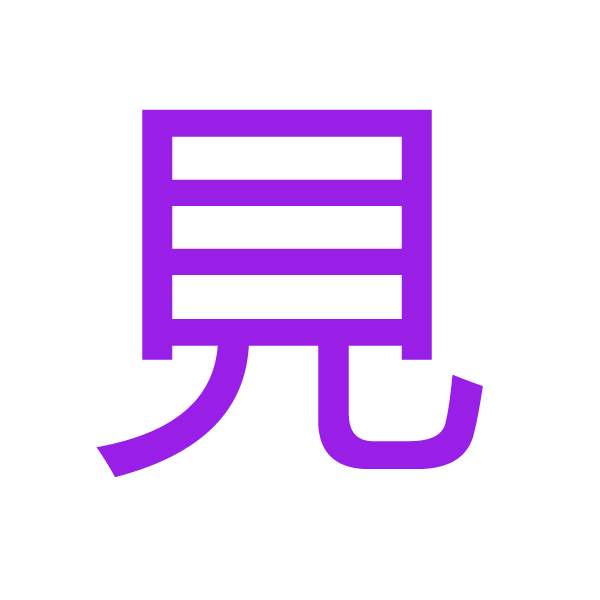
The Kanji: 見 (Mi.ru/Ken) - The "See" Kanji
The kanji "見" is a fundamental character representing the act of "seeing," "looking," or "viewing." It is a logical and visually intuitive character that combines the human faculty of sight with the person who is seeing.
1. Meaning and Usage
Core Meanings: To see; to look; to watch; to be visible; view; perspective.
Readings:
Kun'yomi (Japanese reading): み.る (mi.ru), み.える (mi.eru)
On'yomi (Chinese reading): ケン (ken)
Common Words and Compounds:
見る (みる / miru) - To see; to look; to watch
意見 (いけん / iken) - Opinion (A "view" one holds)
発見 (はっけん / hakken) - Discovery (To "emit/publish" a "seeing")
見学 (けんがく / kengaku) - Observation; field trip (To "see" and "learn")
見本 (みほん / mihon) - Sample; model (Something to "look" at as the "origin")
2. Writing and Stroke Order: The Eye of the Beholder
The correct kanji writing for "見" is a classic top-bottom structure. Mastering its stroke order is essential for writing it fluidly and correctly.
Stroke Order:
The character is composed of the top component 目 (me - "eye") and the bottom component 儿 (a variant of 人, hito - "person").
Top Component (目 - Eye):
Stroke 1: Left vertical stroke.
Stroke 2: Top horizontal and right vertical stroke (one continuous motion).
Stroke 3: Two short horizontal strokes inside the box, written from left to right.
Stroke 4: Bottom horizontal stroke.
Bottom Component (儿 - Human Legs):
Stroke 5: A left-falling stroke that starts from the bottom-left of the "eye."
Stroke 6: A final right-falling stroke with a hook, which starts slightly to the right and sweeps down. This stroke should extend slightly beyond the left one, forming a stable base.
Significance of Correct Kanji Writing:
Proportions: The top "eye" (目) and the bottom "legs" (儿) should be of roughly equal height. The character should look balanced, as if a person is standing firmly, looking straight ahead.
The "Eye" Radical: Recognizing that the top part is the "eye" kanji is crucial. This is the semantic core of the character.
Stability: The two bottom strokes must form a wide, stable base to support the character, preventing it from looking top-heavy.
3. Historical Origin and Evolution
The history of "見" is a perfect example of a logical ideogram that has remained consistent for millennia.
Oracle Bone Script (甲骨文字):
The earliest form was a brilliantly clear pictograph. It depicted a large, exaggerated eye (目) on top of a person (人) in a kneeling or standing posture. The entire meaning of the character was focused on the eye, emphasizing the act of seeing.
Bronze Script (金文) & Seal Script (篆書):
The form became more stylized. The "person" component became more abstract, but the large eye remained the dominant and unmistakable feature of the character.
Modern Form (楷書):
The modern "見" is a clean abstraction of its ancient form. The exaggerated eye has been standardized into the regular kanji for "eye" (目), and the kneeling person has been stylized into the component 儿. While less pictographic, the core concept of "a person (儿) with an eye (目)"—and therefore, the act of seeing—is perfectly preserved.
Philosophical and Cultural Connection:
"見" represents more than just physical vision. In Japanese culture, it encompasses perception, judgment, and experience.
Passive vs. Active Seeing: The verb 見える (mieru) means "to be visible" (something can be seen), which is a passive state. In contrast, 見る (miru), "to see," is an active action. This character underlies both.
Insight and Perspective: As seen in 意見 (iken - opinion), "見" relates to one's personal viewpoint or perspective on the world.
Discovery: 発見 (hakken - discovery) is the act of "making something seen," of bringing something into view for the first time.
Summary
The kanji "見" is a character of elegant logic and enduring form. It began as a literal drawing of a person with a prominent eye and evolved into the essential symbol for the act of seeing. Mastering its stroke order is a fundamental step in Japanese kanji writing, as it is a common character and a radical for others related to vision. When you learn how to write kanji like "見," you are not just learning a word for "to see"; you are learning a character that gives form to the very act of perception, from a simple glance to a profound insight. It is the embodiment of the human gaze.